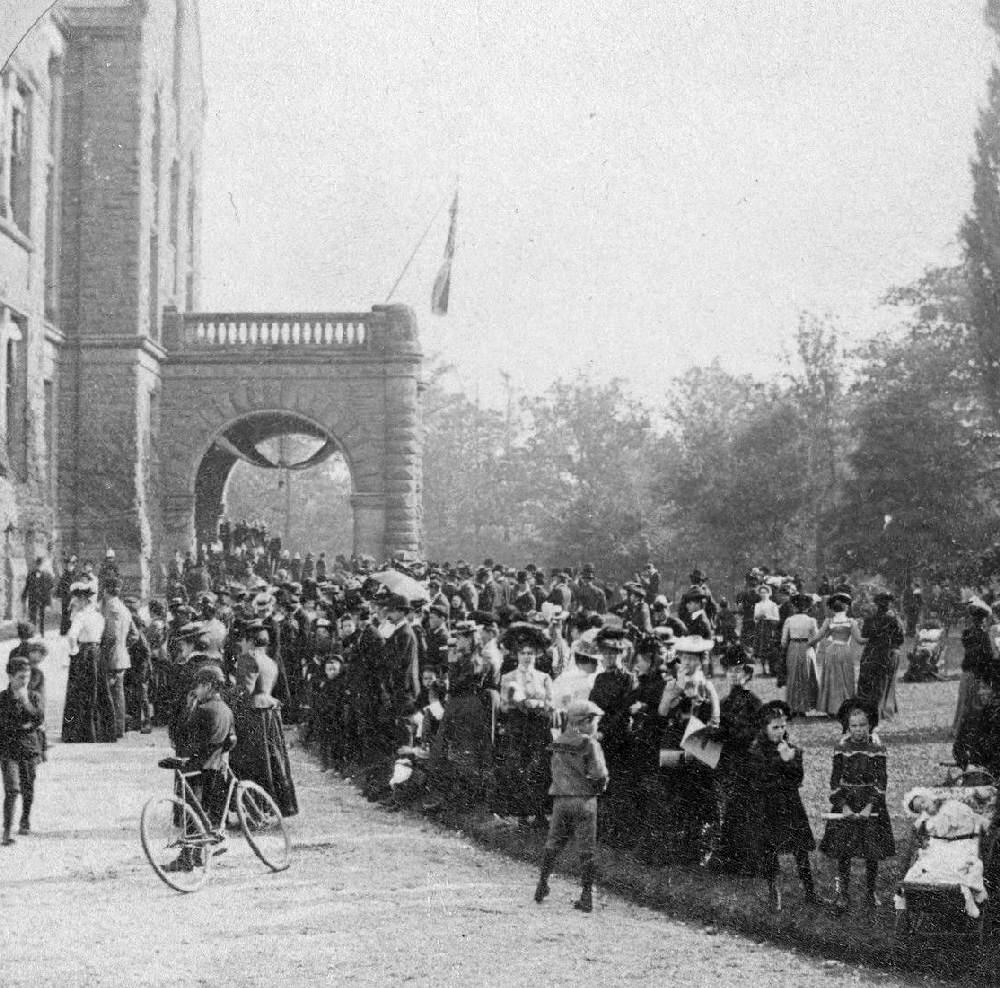
Canadian History: Federation and Dominion (1867)

Figure 1.--The American colonial legislatures proved so bothrsome that when Britain seizd control of Canada (1763), it did not establish elected legislatures. It was not until the Act of Union (1840) that representative government was permotted, but major parts of British North America were not included. The decisive step, promted by the American Civil War was the British North America Act (1867). A Canadian Parliament was created leading very quickly to domestic self government. Canada thus became the first Dominion, a term created to differentiate it from a colony. This is the opening of the Ontario provincial Legislative Assemby (parliament) in Toronto during 1902.
|
|
Canada did not exist as a political unit, even a colonial unit in the early-19th century. The union of East and West Cana (1840) was a major step but did not include major parts of what we know know as Canada. The British administered Canada as a group of separate colonies. Unlike America to the south there was little sence of a national identity. The term Canada was not widely used and had not basis in law. Provincial leaders gradually began to think of a unified Canada. The American example was probably a powerful influence. Unlike the United States to the south, there was little tradition of elected legislatures. The British had so much trouble with the colonial legislatures in the 13 colonies that they did not want to deal with any more. The American Civil War helped to promote discussions which focused on federation and the need for a national elected legislature. The United States emerged from the Civil War as a still united country with enormous military power and political energy. It was clear to both British authorities and provincial leaders that only federation and democratic reforms would prevent at least some of the provinces from being absorbed into the growing American colosus. Irish immigrants in America helped to highlight the potential problem. Irish nationalism could not be supressed by the British in the Irish immigrant community of the United Stastes. The strongest expression was the virulently anti-English Fenians. They conceived of the idea of striking at Britain by invading Canada. The Fenians as a result of the Civil War had menbers with military experience. They carried out a series of border raids. British officials drove them back into America and U.S. authorities acted to porevent further such raids, but they were a clear illustration that Canada required a central authority and the event helped to generate a degree of nationalist sentiment which increased support for federaton. A conference was held in Charlottetown, Prince Edward Island to discuss a federal union (1864). Macdonald with Brown and Cartier led a Canadian deleation and met with represenatives from the Maritimes. They agreed that the idea of federation had merit and should be discussed in more detail. The result was the Quebec Conference held later in the year. The first major step toward federation was the resulting Seventy-Two Resolutions. This provided a basic framework for uniting the British provinces and colonies into a federation. A majority of the of the provinces adopted them. This led to the London Conference (1866). As a result the Dominion of Canada was established (1867). Support for federation from both Britain and the provinces was obtained for a variety of reasons. And British policy favored some kind of union, in large part to establish a political force capable of resisting American expansionism and maintaining the rule of law, especially in the still lightly setteled prarie privinces. The economic future of the Maritimes required railroad connections with the interior. British-Canadian nationalism was developing and nationalist leaders saw a need for political union based on English law and language and British culture. French-Canadians saw an opportunity within the new Dominion to achieve political power in a new largely French-speaking Quebec. Many leaders thought that a Dominion parliment and provincisal parliasments could end the contentious split between upper and lower Canada. The British Parliment passed the British North America Act (1867). This made the Province of Canada, New Brunswick, and Nova Scotia became a federated kingdom which was to be termed a Dominion. The term recognized Canada's status as self-governing colony. Canada became the first Dominion. As in all federations, poltical differences centered on the strength of the central governmnt. One force was the liberal Reform movement of Upper Canada and the French-Canadian rouges (Red Party) in Lower Canada who supported a decentralized union. The Upper Canadian Conservative party and to some degree the French-Canadian bleus (Blue Party) supported a strong central government. John A. Macdonald was chosen as the first prime minister.
CIH

Visit Children in History Website:
[Return to the Main Canadian history page]
[Return to the Main North American history page]
[Return to the Main French Canadian page]
[Return to the Main Canadian country page]
[Canadian art]
[Canadian catalogs]
[Canadian choirs]
[Canadian families]
[Canadian First Communions]
[Canadian long stockings]
[Canadian school uniform]
[Canadian television]
[Canadian youth groups]
Navigate the Boys' Historical Clothing Web Site:
[Introduction]
[Animals]
[Biographies]
[Chronology]
[Climatology]
[Clothing]
[Disease and Health]
[Economics]
[Ethnicity]
[Geography]
[History]
[Human Nature]
[Law]
[Nationalism]
[Presidents]
[Religion]
[Royalty]
[Science]
[Social Class]
[Bibliographies]
[Contributions]
[FAQs]
[Glossaries]
[Images]
[Links]
[Registration]
[Tools]
[Children in History Home]
Created: 5:47 AM 3/12/2018
Last updated: 5:47 AM 3/12/2018



